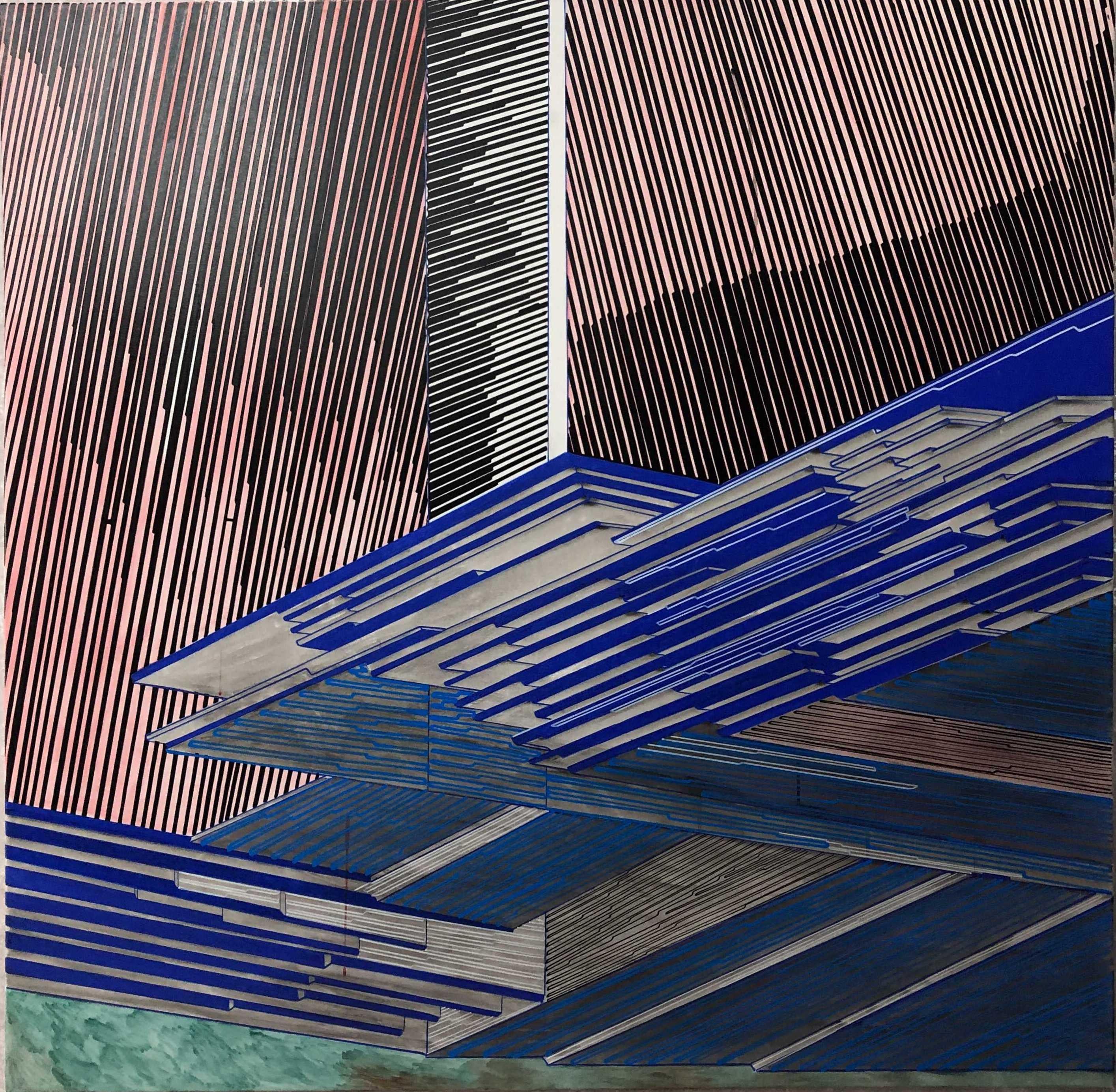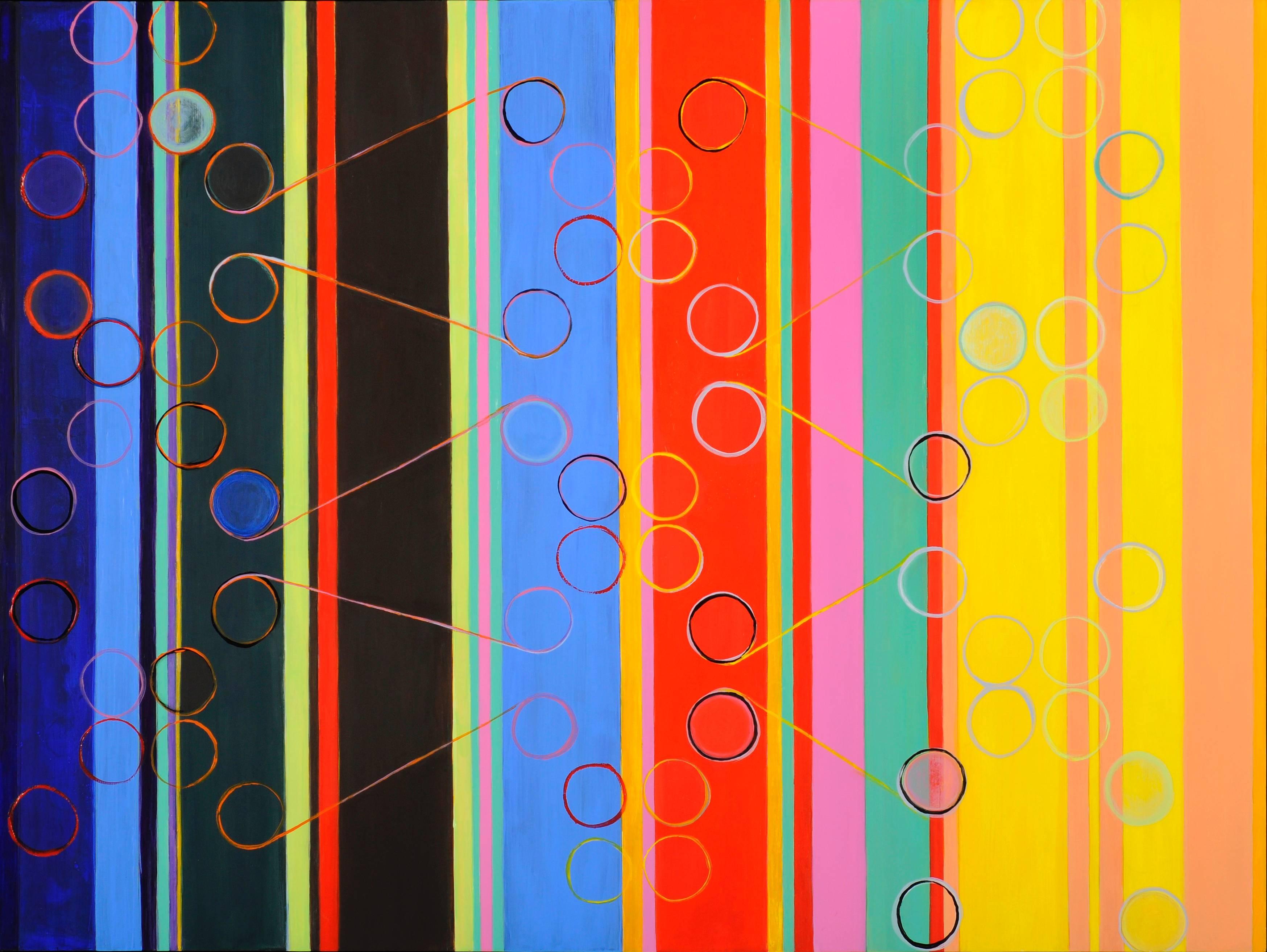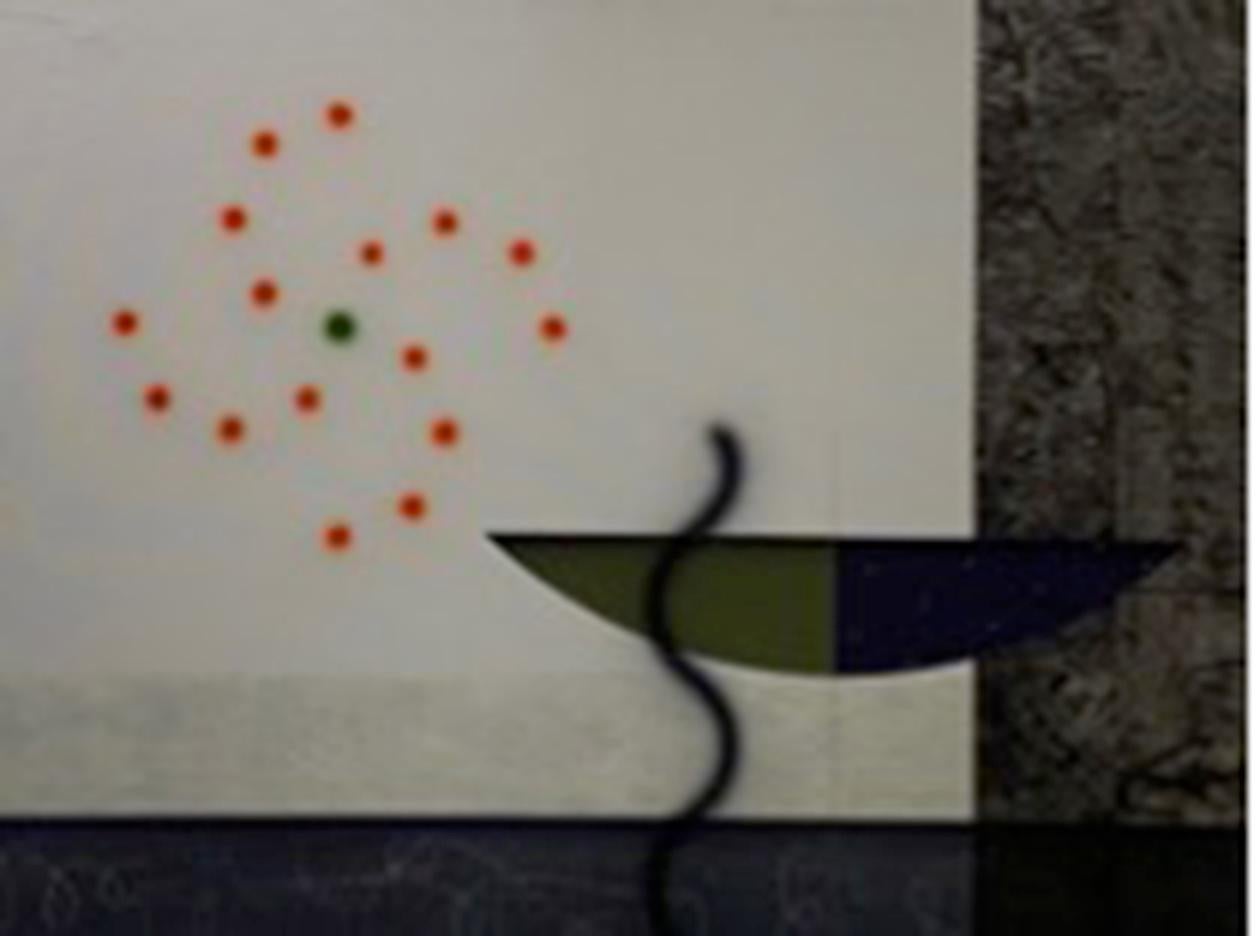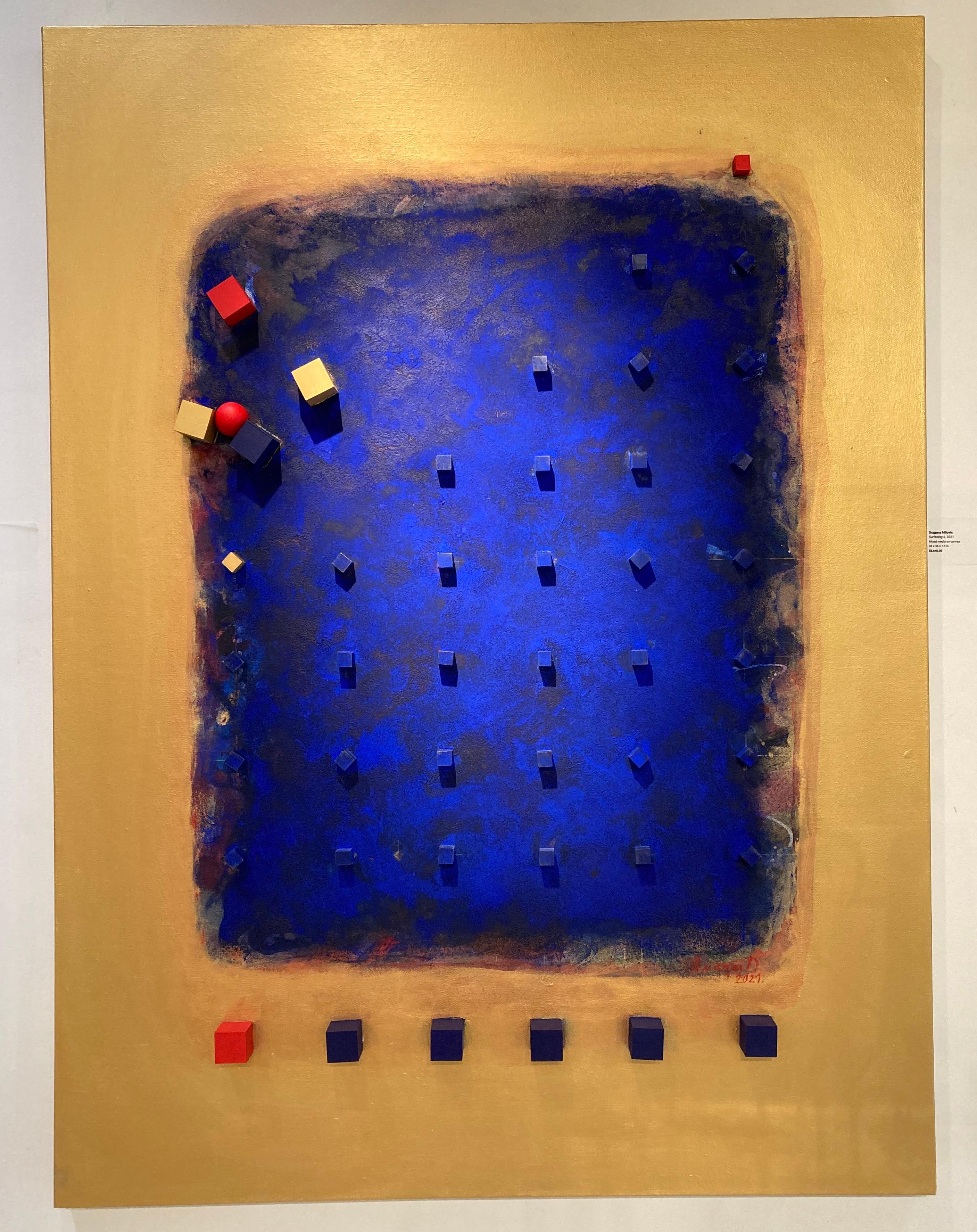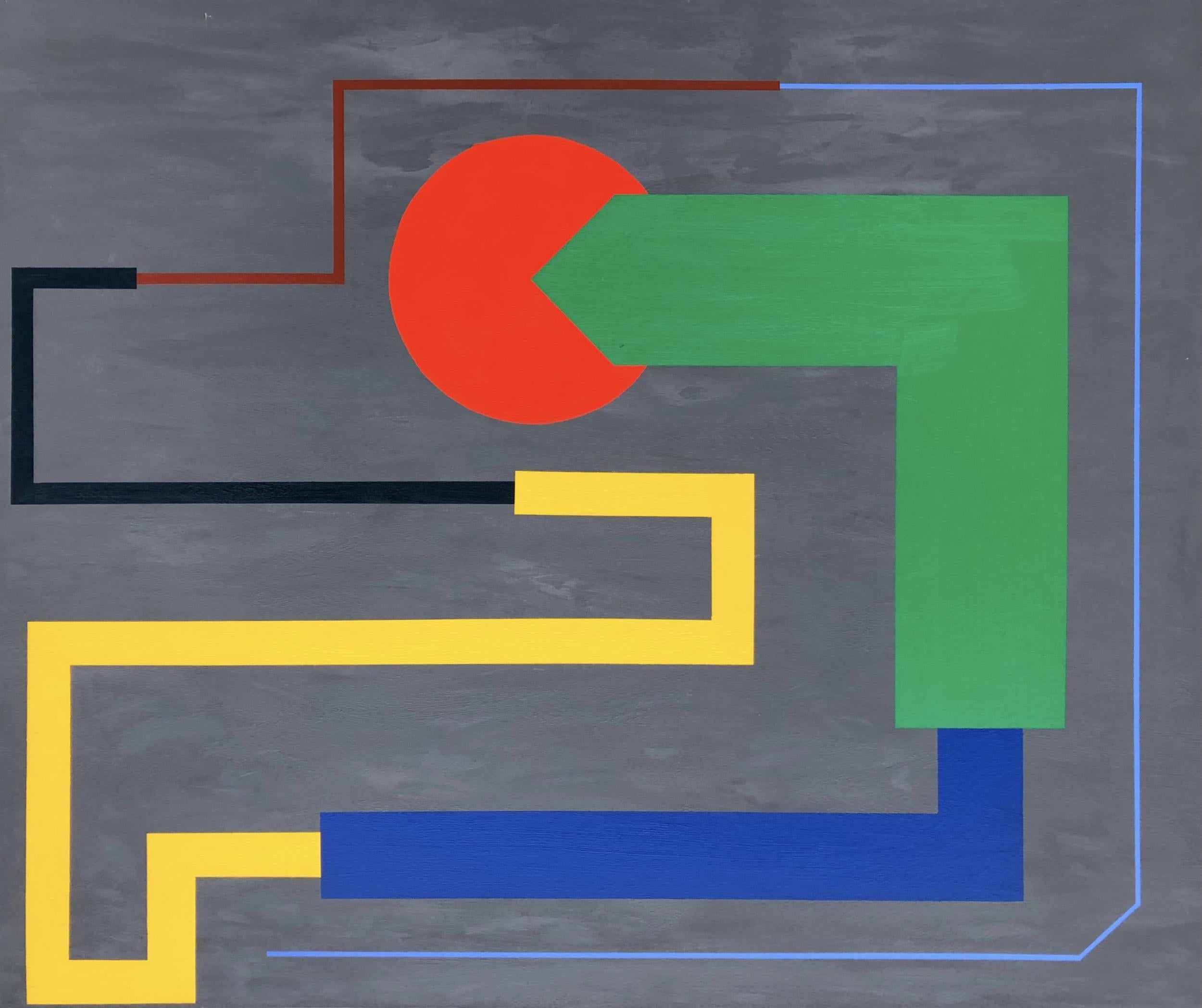Items Similar to "Untitled" Dan Christensen, Geometric Plaid Series, Orange and Blue Abstract
Want more images or videos?
Request additional images or videos from the seller
1 of 8
Dan Christensen"Untitled" Dan Christensen, Geometric Plaid Series, Orange and Blue Abstractcirca 1970-71
circa 1970-71
About the Item
Dan Christensen
Untitled, circa 1970-71
Acrylic and enamel on canvas
44 x 20 inches
Provenance:
The artist
Sherron Francis (gift from the above)
Dan Christensen was an American abstract artist. An art critic, Clement Greenberg, described Dan Christensen’s art as Color Field or Post-Painterly Abstraction. One of the American leading abstract artists, Dan Christensen art was expressed through the use of both line and color. But apart from being abstract, Dan Christensen art and paintings offer a wide variety of styles, including modernism.
Inspired by the artwork of Jackson Pollock at an early age, artist Dan Christensen spent 40 years painting. And not only painting, but exploring everything connected to the art of painting. As a result, Dan Christensen art and paintings were original, joyful and surprising. He was innovative at the time when painting was dead. He was also a truly dedicated artist and his work meant a lot to him. Dan Christensen artist and painter, came up with the term “the harmonious turbulence of the universe”. This turbulence came from his exploratory approach to creating artwork.
Artist Dan Christensen was born in Cozad, Nebraska, in 1942. He graduated from high school in North Platte, and later attended Chadron State College in the late 1950s, where his artistic talent was first recognized by his professors. He transferred to the Kansas City Art Institute, where he studied alongside Sherron Francis and graduated as class valedictorian in 1964.
In 1964, artist Dan Christensen moved to New York, where he worked at various jobs – as a bartender, carpenter and many other things, while starting his career as an artist. It happened then and there that Dan Christensen art was influenced by the city and the art world of New York.
In 1967, Dan Christensen art made the move from figuration to abstract painting. He started producing paintings with a spray gun, giving them the definition of abstract and original. He drew loops, lines and colorful stacks on his paintings, which made his art instantly noticeable and got him his first artwork exhibition at the Andre Emmerich Gallery.
Two years later, in 1969, Dan Christensen art took a new course. He started creating geometric “plaid” paintings, and had a first one-person show at the same Andre Emmerich Gallery, along with the prominent Kenneth Noland, Jules Olitski and Helen Frankenthaler. One of Dan Christensen most famous paintings, Lisa’s Red is from this period. This painting was included in an exhibition of his work from 1966 to 2006. The exhibition was held at Sheldon Museum and was titled “Dan Christensen: Forty Years of Painting”.
In the 1970s and 80s, artist Dan Christensen was exploring new techniques. At that time, Dan Christensen was already an acclaimed artist in New York. But as Jacobshagen said, outside New York, probably nobody knew him. Keith Jacobshagen, a Lincoln painter, had a good feeling about Dan Christensen’s artistic talent from the very first beginning of his career as an artist. He was at the Kansas City Art Institute with Christensen in the early 1960s and said – “He had a real nice sense of skill and of touch. He was painting figuratively at that time. It wasn’t until Dan Christensen moved to New York and was influenced by the city and the New York art world that he started painting abstraction.” Along with Jacobshagen, Kennedy, the curator of Sheldon Museum of Art supported Dan Christensen’s art. He described artist Dan Christensen as innovative and a really dedicated artist. Both of them consider that no one but Dan Christensen managed to gain a national reputation at that time, and no one but he was supposed to. But before them, there was an architect, Philip Jonson, who supported his art from his early steps. He bought some Dan Christensen art and even gave one painting to the Museum of Modern Art.
Fifty years later, in the 2000s, Dan Christensen is the most noted Nebraska native artist of his era, and a highly regarded artist and painter. Artist Dan Christensen’s unique approach to line and shape was even researched at the Butler Institute of American Art, Ohio. Dan Christensen art is now highly regarded everywhere. His paintings are highly collectible and widely held by both art collectors and museums. It can now be difficult to find Dan Christensen art for sale, and Kennedy, the curator of the Sheldon Museum of Art, claims that Dan Christensen should have been recognized much earlier.
Artist Dan Christensen spent his whole life creating art. From the 1970s to the very end of his life he was exploring new art and painting techniques. Dan Christensen spent the end of his life in East Hampton. He died in 2007, but Dan Christensen art is now more alive than ever. The collectors are buying his art and the exhibitions of his work are being held around the USA.
- Creator:Dan Christensen (1942 - 2007, American)
- Creation Year:circa 1970-71
- Dimensions:Height: 45 in (114.3 cm)Width: 21 in (53.34 cm)
- Medium:
- Movement & Style:
- Period:
- Condition:
- Gallery Location:New York, NY
- Reference Number:1stDibs: LU1841213149092
About the Seller
5.0
Platinum Seller
These expertly vetted sellers are 1stDibs' most experienced sellers and are rated highest by our customers.
Established in 2021
1stDibs seller since 2022
59 sales on 1stDibs
Typical response time: 1 hour
- ShippingRetrieving quote...Ships From: New York, NY
- Return PolicyA return for this item may be initiated within 3 days of delivery.
More From This SellerView All
- "Untitled" Mario Yrisarry, Geometric Abstraction, Color Field, Rainbow SquaresBy Mario YrisarryLocated in New York, NYMario Yrisarry Untitled, 1973 Signed and dated on the overlap Acrylic on canvas 48 x 48 inches Provenance: Private Collection, Ellicott City, Maryland ...Category
1970s Abstract Geometric Abstract Paintings
MaterialsCanvas, Acrylic
- "Jean Jean" Larry Zox, Color Field, Geometric Abstraction, Hard-Edge, YellowBy Larry ZoxLocated in New York, NYLarry Zox Jean Jean, 1964 Signed, dated, and titled on the stretcher Liquitex on canvas 58 x 62 inches Provenance: Solomon & Co., New York Private Collection, NJ Estate of the above, 2023 Committed to abstraction throughout his career, Larry Zox played a central role in the Color Field discourse of the 1960s and 1970s. His work of the time, consisting of brilliantly colored geometric shapes in dynamic juxtapositions, demonstrated that hard-edge painting was neither cold nor formalistic. He reused certain motifs, but he did so less to explore their aspects than to “get at the specific character and quality of each painting in and for itself,” as James Monte stated in his essay for Zox’s solo exhibition at the Whitney Museum of American Art in 1973. By the 1970s, Zox was using a freer, more emotive method, while maintaining the autonomy of color, which increasingly became more important to him than structure in his late years. Zox began to receive attention in the 1960s, when he was included in several groundbreaking exhibitions of Color Field and Minimalist art, including Shape and Structure (1965), organized by Henry Geldzahler for the Gallery of Modern Art, New York, and Systemic Painting (1966), organized by Lawrence Alloway for the Guggenheim Museum. In 1973, the Whitney’s solo exhibition of Zox’s work gave recognition to his significance in the art scene of the preceding decade. In the following year, Zox was represented in the inaugural exhibition of the Hirshhorn Museum, which owns fourteen of his works. Zox was born in Des Moines, Iowa. He attended the University of Oklahoma and Drake University. While studying at the Des Moines Art Center, he was mentored by George Grosz, who despite his own figurative approach encouraged Zox’s forays into abstraction. In 1958, Zox moved to New York, joining the downtown art scene. His studio on 20th Street became a gathering place for artists, jazz musicians, bikers, and boxers. He occasionally sparred with the visiting fighters. He later established a studio in East Hampton, where he painted and fished including using a helicopter to spot fish. In the 1950s and early 1960s, Zox’s works were collages consisting of painted pieces of paper stapled onto sheets of plywood. He then produced paintings that were illusions of collages, including both torn- and trued-edged forms, to which he added a wide range of intense hues that created ambiguous surfaces. Next, he omitted the collage aspect of his work and applied flat color areas to create more complete statements of pure color and shape. From 1962 to 1965, he produced his Rotation Series, at first creating plywood and Plexiglas reliefs, which turned squares into dynamic polygons. He used these shapes in his paintings as well, employing white as a foil between colors to produce negative spaces that suggest that the colored shapes had only been cut out and laid down instead of painted. The New York Times noted in 1964: “The artist is hip, cool, adventurous, not content to stay with the mere exercise of sensibility that one sees in smaller works.” In 1965, he began the Scissors Jack...Category
1960s Abstract Geometric Abstract Paintings
MaterialsCanvas, Acrylic
- "Ouverture, with Cypress Forms" Stephen Edlich, Abstract Geometric PaintingBy Stephen EdlichLocated in New York, NYStephen Edlich Ouverture, with Cypress Forms, 1982 Signed, dated and titled on the stretcher Acrylic paint, mixed media, and burlap on canvas 60 x 40 inches An artist who worked in the post-cubist and constructivist traditions, Stephen P. Edlich gained a considerable amount of acclaim in the 1970s and 1980s for his collages, sculpture, and paintings. His promising career was cut short due to his untimely death at age 45 in 1989. Edlich was born in New York City. He received his undergraduate degree with a major in fine arts studies from New York University in 1967. During his college years, he traveled to London, where he met the art dealer Victor Waddington and created his first white on white collage. In that same year, he attended a major exhibition of the work of Ben Nicholson, which would be influential source in his art. Edlich returned to England in 1967, where he met Barbara Hepworth and Patrick Heron in London and traveled to St. Ives, Cornwall, long a favorite artists' haunt. Edlich began creating acrylic reliefs...Category
1980s Abstract Geometric Abstract Paintings
MaterialsCanvas, Burlap, Mixed Media, Acrylic
- "Message I, " Boris Margo, White Surrealist 3D PaintingBy Boris MargoLocated in New York, NYBoris Margo (1920 -1995) Message I, circa 1970 Stretched canvas over relief 22 x 27 x 1 1/2 inches Best known as a painter of surrealist imagery, Boris Margo was born in Wolotschisk, Ukraine, in Russia. In 1919 he enrolled at the Polytechnik of Art at Odessa, and in 1924 received a grant to study at the Futemas (Workshop for the Art of the Future) in Moscow. A second grant enabled him to study the work of the Old Masters in the Hermitage Museum in Leningrad and to attend Pavel Filonov's Analytical School of Art in 1927. In 1928 Margo received a certificate from the Polytechnik and immigrated to Montreal, where he worked as a muralist for a year. Moving to New York City in 1930, he studied at the Roerich Museum, and two years later began teaching there. He began experimenting with celluloid and acetone in his printmaking and was also an early user of the decalomania technique in oil painting. In 1943 he became an American citizen. Five years later Margo founded a Creative Art Seminar (later called Artists Gallery) in Orlando, Florida, and a year later established a similar venture in Provincetown, Massachusetts. Margo's first solo exhibition was at the Artists Gallery in New York City. Other important shows were held at the Brooklyn Museum, the Tweed Gallery at the University of Minnesota, Duluth, and the Michael Rosenfeld...Category
1970s Abstract Geometric Abstract Paintings
MaterialsCanvas
- "Untitled, " Knox Martin, Abstract ExpressionismBy Knox MartinLocated in New York, NYKnox Martin (1923 - 2022) Untitled Signed to lower edge Acrylic and gold foil on canvas 9 x 9 inches Knox Martin (1923-2022) was an esteemed New York School painter. Knox Martin was born in 1923 in Barranquilla, Colombia. He was the son of the aviator, painter, and poet William Knox Martin, the first man to fly over the Andes Mountains. After serving in World War II, Knox Martin attended the Art Students League of New York on the G.I. Bill from 1946-1950, where he studied with Harry Sternberg, Vaclav Vytlacil, Will Barnet, and Morris Kantor. In 1954, Knox Martin's friend Franz Kline placed a painting of his in the Stable Gallery Annual. Charles Egan of the renowned Charles Egan Gallery saw Knox Martin's painting at the Stable Gallery and asked Martin to show his work in a one-man show for the tenth anniversary of the Egan Gallery. Since then, Knox Martin was a celebrated painter, sculptor and muralist. Knox Martin had an extensive exhibition record and his work is in museum, corporate and private collections worldwide. His two best-known murals in NYC are Venus and Woman with Bicycle...Category
Late 20th Century Abstract Abstract Paintings
MaterialsGold, Foil
- "Night Road" Gerome Kamrowski, Abstract Expressionism Surrealism, Purple ImpastoBy Gerome KamrowskiLocated in New York, NYGerome Kamrowski (1914 - 2004) Night Road, 1966 Acrylic on canvas 58 1/4 x 96 1/4 inches Signed and dated Provenance: The Artist The Kamrowski Estate (by family descent in 2004) Exhibited: The Detroit Institute of Arts, Detroit, Michigan, 56th Exhibition for Michigan Artists, November 18 - December 31, 1966, no. 32, illustrated (Night Road was the winner of the "Phyllis King Weiner Memorial Prize" at this exhibition). Ann Arbor, University of Michigan Museum of Art, Gerome Kamrowski: A Retrospective Exhibition, August 30 - October 16, 1983, no. 70, illustrated. Tarpon Springs, Florida, Leepa-Rattner Museum of Art, St. Petersburg College, Gerome Kamrowski: An American Surrealist, September 8 - October 27, 2002, no. 23. Chelsea, Michigan, River Gallery, Gerome Kamrowski: 1914-2004, A Memorial Retrospective, October 30 - December 5, 2004. Gerome Kamrowski was born in Warren, Minnesota, on January 19, 1914. In 1932 he enrolled in the Saint Paul School of Art (now Minnesota Museum of American Art - MMAA), where he studied with Leroy Turner, and Cameron Booth. Both Turner and Booth had been students of Hans Hofmann, and were also associated with the Abstraction-Création group in Paris. It was from these peers that Kamrowski was introduced to a "kind of expressionist cubism." In 1933 Kamrowski was awarded a scholarship to the Art Students League, where he would study in New York under Hans Hofmann. Unfortunately, immigration problems had prevented Hofmann from assuming his post. Nevertheless, Kamrowski decided to remain in New York for a short time, to attend classes taught by George Grosz. After a few weeks, he returned to St. Paul, and found a position in the mural painting division of the Minnesota FAP/WPA (Works Progress Administration). In 1936 he contributed “Synthetic Cubist Style” frescoes in the Northrup Auditorium of the University of Minnesota. In 1937 Kamrowski went to Chicago to study under László Moholy-Nagy and Alexander Archipenko at the New Bauhaus (now Illinois Institute of Technology's Institute of Design). There he was exposed to new and interesting ideas regarding the role of nature in art and the "geometric basis of natural form". In 1938 Kamrowski received a Guggenheim fellowship to attend Hans Hofmann's summer school in Provincetown, Massachusetts. He then relocated to New York where he met William Baziotes. Together they shared a fascination in Surrealist automatic writing, and both artists explored its possibilities in their paintings. Kamrowski was particularly drawn to Surrealism's fundamental appeal of intuition over intellect. He was interested seeking a process that "binds all things together...a kind of cosmic rhythm". Throughout the late 1930s and early 1940s while living in New York, Kamrowski became an integral part of the emerging surrealists. In 1942, the artist Roberto Matta attempted to form a group of artists to investigate new applications for Surrealist methods. He invited Kamrowski, along with William Baziotes, Jackson Pollock, Peter Busa...Category
1960s Abstract Expressionist Abstract Paintings
MaterialsCanvas, Acrylic
You May Also Like
- Mars BaseBy Vargas-Suarez UniversalLocated in New York, NYMars Base, 2020 Signed, titled and dated 2020 Bishkek, Kyrgyzstan Acrylic oil enamel and oil on linen 52 x 52 inCategory
2010s Abstract Geometric Abstract Paintings
MaterialsEnamel
- Ellen Hackl Fagan, Molecules of Music, 2014, Enamel, Acrylic, Clay BoardBy Ellen Hackl FaganLocated in Darien, CTEllen Hackl Fagan creates works of art focused on building a visual language. Molecules of Music is a large acrylic painting based on crowd sourced input of viewers pairing sounds from the Do Re Mi musical scale to colors. 260 people submitted their opinions on color to sound matches. Language is a recurring theme in Fagan's work, ranging from interactive, ColorSoundGrammar works to painting, sculpture, lost languages...Category
2010s Abstract Geometric Abstract Paintings
MaterialsEnamel
- Totem, 2020, acrylic, oil, marker, liquid gold leaf, op-art, pattern, red, blueLocated in Jersey City, NJTotem, 2020, acrylic, oil, artist marker, liquid gold leaf, op-art, pattern, red, blue, yellow.Category
2010s Abstract Geometric Abstract Paintings
MaterialsGold Leaf
- "Cycle, " Acrylic, Gold and Silver Leaf on Canvas - MinimalistBy Parinya TantisukLocated in Houston, TXEver-turning, life's inevitable cycle of birth and death, reminds us of the rising and falling of all things. Artwork Details: Parinya Tantisuk "Cycle" 1996 Acrylic, Gold and Silv...Category
1990s Abstract Geometric Abstract Paintings
MaterialsGold Leaf
- 'Surfacing II, ' by Dragana Milovic, Mixed Media PaintingLocated in Oklahoma City, OKThis 48" x 34" mixed media painting, 'Surfacing II,' by Dragana Milovic features an abstracted geometric composition featuring 3d objects adhered to th...Category
2010s Abstract Geometric Abstract Paintings
MaterialsGold Leaf
- Abstract Landscape - Minimalist Paint made in ItalyBy Marilina MarchicaLocated in Agrigento, AGLandscape mixed media on canvas 80x80 cm Original Art Signed on Back Landscape is a series of artworks inspired by landscape and nature, nature and the passage change over time, we ...Category
2010s Abstract Geometric Abstract Paintings
MaterialsEnamel
Recently Viewed
View AllMore Ways To Browse
Dan Jackson
Landscape And Horizontal
Gratz Gallery Conservation Studio
G Campbell
Snow White Cell
Kim B
Galerie Bruno Massa
Bronze Japanese Book End
2 Carrot Ring
Savoir No 2 Bed
Beige Navy Paintings
Arthur Coppedge
Christopher Dunham
Elaine Elliott
Genesis By Mario
Mark Leckey
Mercedes Benz Maybach
Molly Mason Sculpture
